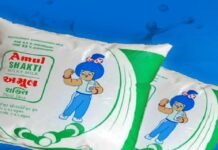
Key Points
- Nationwide Price Hike: Amul and Mother Dairy have both raised milk prices by ₹2 per litre, effective April 30 and May 1, 2025, respectively.
- New Retail Rates: Mother Dairy’s full cream milk now costs ₹69/litre in Delhi-NCR; Amul Gold is ₹67/litre in Gujarat, with similar increases on all variants.
- Why the Hike? The increase is due to a sharp rise in procurement costs for raw milk, driven by early heatwaves, water shortages, and higher cattle feed prices.
- Impact on Consumers: The hike represents a 3–4% increase in retail price, but is still below overall food inflation rates.
- Dairy Sector Outlook: Despite higher prices, milk demand remains robust, and most of the increased revenue goes to support dairy farmers.
New Delhi: India’s leading dairy brands, Amul and Mother Dairy, have announced a nationwide hike in milk prices by ₹2 per litre, sending ripples through household budgets and the country’s massive dairy industry. The new prices take effect for Mother Dairy from April 30 and for Amul from May 1, 2025, impacting millions of consumers from Delhi-NCR to Gujarat and beyond.
How Much Has Milk Become Costlier?
- Mother Dairy (Delhi-NCR):
- Full Cream Milk: ₹69/litre (up from ₹68)
- Toned Milk (pouch): ₹57/litre (up from ₹56)
- Double Toned Milk: ₹51/litre (up from ₹49)
- Cow Milk: ₹59/litre (up from ₹57)
- Bulk Vended (Toned): ₹56/litre (up from ₹54)[2][6]
- Amul (All India):
- Amul Gold: ₹67/litre (up from ₹65)
- Amul Taaza: ₹55/litre (up from ₹53)
- Amul Shakti (Standard): ₹62/litre (up from ₹60)
- Amul Buffalo Milk: ₹73/litre (up from ₹71)
- All variants, including Slim n Trim, Chai Mazza, and Cow Milk, see a ₹2/litre increase.
Why Are Milk Prices Rising?
Both Amul and Mother Dairy attribute this price hike to a significant increase in the cost of procuring raw milk from farmers. Over the past few months, procurement costs have surged by ₹4–5 per litre, mainly due to:
- Early and Intense Heatwaves: The unusually hot weather has led to a drop in milk production, as cattle yield less milk under stress and water scarcity.
- Rising Input Costs: Cattle feed, fodder, and maintenance costs have increased sharply, squeezing farmers’ margins.
- Supply Chain Pressures: Higher operational costs, including transport and logistics, have further contributed to the price hike.
- Supporting Farmers: Both cooperatives emphasize that the majority of the price hike benefits their network of millions of dairy farmers, helping offset increased costs and sustain milk production.
What Does This Mean for Consumers and the Dairy Industry?
- Household Budgets: The hike will impact daily expenses, especially for families with high milk consumption, but is seen as necessary to ensure the continued supply of quality milk.
- Industry Growth: Despite rising prices, India remains the world’s largest milk producer, with robust demand and government targets to further boost production to 300 million metric tons in the next five years.
- Farmer Support: About 80% of the additional revenue from the price hike is returned to milk producers, supporting rural livelihoods and encouraging sustainable dairy farming.
Will Prices Rise Further?
Industry experts note that while this is the first major hike since June 2024, further increases could occur if input costs continue to climb or if extreme weather persists. However, the cooperatives stress that they aim to balance consumer affordability with fair compensation for farmers.
Amul and Mother Dairy’s ₹2/litre price hike reflects mounting pressures from heatwaves, rising feed costs, and supply chain challenges. While the move will pinch consumers, it is crucial for sustaining India’s dairy sector and supporting millions of farmers. With demand for milk still strong, the industry is expected to remain resilient, though further price adjustments cannot be ruled out if input costs keep rising.











































